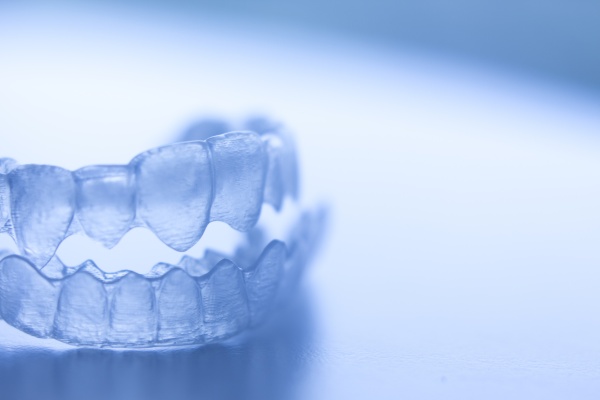Truths and Myths About Invisalign Aligners

Similar to braces, Invisalign® aligners are a type of treatment used to straighten teeth. This procedure uses a series of plastic aligners that are changed every two weeks to achieve the desired results. It is becoming a popular option, but there are a lot of misunderstandings about it. Here are the facts and some of the most common myths surrounding this treatment.
The truths about Invisalign®
These aligners are customized to fit each individual patient’s mouth. Patients receive a series to wear during the course of treatment. Each aligner targets certain teeth to move them until the desired result is achieved. The aligners offer more flexibility than standard braces due to the ability to remove them.
The aligners are made from a clear plastic so are nearly invisible. It is important to wear the devices for around 20 to 22 hours a day, but they can be taken out to eat and drink. Most patients finish treatment in the span of a year or so and results are long lasting, providing a proper retainer is worn after treatment ends to prevent teeth from shifting back.
Common myths about Invisalign®
There are a number of widespread myths about these aligners that are still believed today. These are a few of the most common myths:
- Invisalign® causes a lisp: Some patients may be concerned that wearing the aligners could cause a lisp when speaking. However, this is not the case. It is fairly common for patients to have an adjustment period when first getting use to the aligners so speech may be slightly different. This effect usually only lasts a few days and there are no speech issues afterward.
- The results are not as good as traditional braces: In fact, Invisalign® can be just as effective as traditional braces are. However, not everyone is a candidate for this procedure due to specific teeth arrangements and conditions.
- The alignment is painful: Many have heard of the common misconception that these aligners cause patients a lot of pain. It is true that Invisalign® does often cause some minor discomfort as the teeth are shifting and moving, but this is usually short-lived and mild. It most often occurs when a new aligner has been placed and lasts for a few days.
- The treatment is too expensive: Because of its modern methods, this treatment may be believed to be a much more expensive option compared to traditional braces; however, the cost is usually comparable between the two. In addition, most insurance companies pay the same amount for Invisalign® and traditional braces.
- Invisalign® is not for children or senior patients: The aligners are not just for adults. Children can get them as long as they have all of their adult teeth. Elderly patients can also get aligners.
Conclusion
There are a lot of myths regarding Invisalign®, but the procedure can be a great option in place of traditional braces. The aligners are effective, similar in cost to traditional braces and are easy to care for.
Are you considering getting Invisalign® in the Coral Gables area? Get more information at https://www.gablesexceptionaldentistry.com.
Check out what others are saying about our services on Yelp: Read our Yelp reviews.
Related Posts
Teens undergo various challenges and physical transformations, such as treatments to align their teeth, which can significantly impact their self-esteem and confidence. Invisalign® has revolutionized how teens and their parents straighten their teeth. Invisalign for teens can boost their confidence without the need for wires and brackets of traditional braces.One of the main concerns teens…
It can be scary to endure a cracked tooth, especially when it results from dental trauma. This review explains what to do in the event of a cracked tooth. It is important to take a deep breath and handle the immediate aftermath one step at a time.You can help ensure a cracked tooth (or a…
Are you considering Invisalign®? Read on to learn more about this teeth-straightening option. The path to a beautiful smile, complete with straight teeth, can be life-changing. Using braces to straighten teeth has been the standard practice for decades. However, new orthodontic treatments have emerged as a result of technological advances. One such innovation is Invisalign,…
Eating with Invisalign ® aligners will be slightly different from your usual routine, but it is entirely manageable with minor adjustments. We often receive questions about eating with Invisalign, so we have answered the most common ones in this review to help you navigate this aspect of your orthodontic treatment. Understanding what patients can and…
